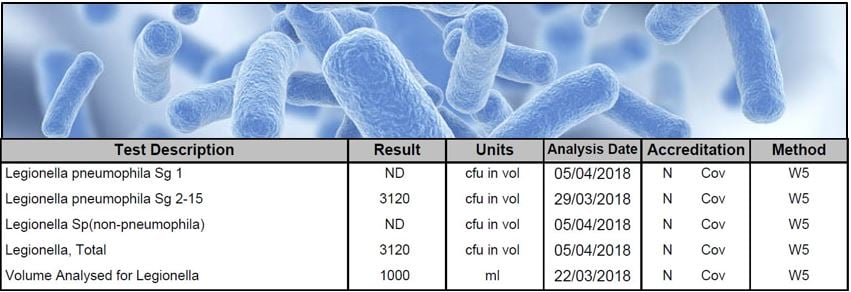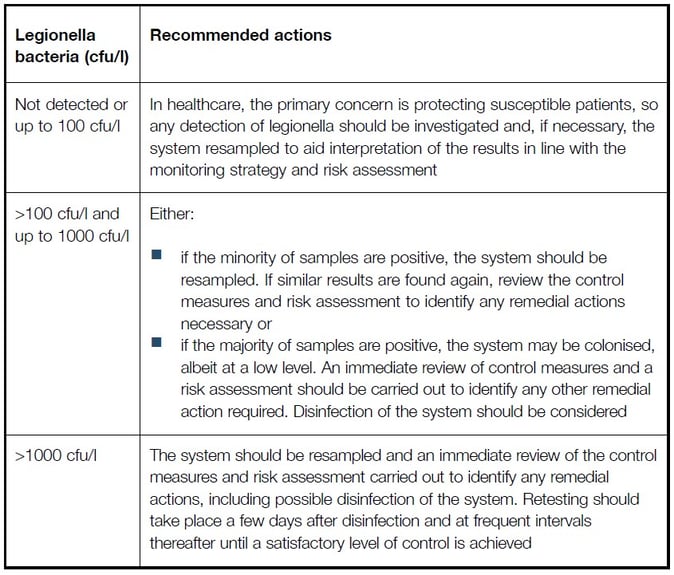The likelihood of Legionella bacteria being present within domestic or other water systems typically comes as no surprise to all those involved with water safety. As we know, Legionella bacteria remain ubiquitous in natural and constructed aquatic environments. It is also true that airborne dispersal of the bacteria may well occur when aerosols or droplet nuclei are created.
As such, the focus of Legionella risk management should certainly be on preventing this known and hazardous bacteria from multiplying in water systems, rather than reacting to a problematic situation. The preventative measures would typically be documented within an organisation’s ‘Written Scheme’ or in a Healthcare environment, their ‘Water Safety Plan’.
However, the presence of a confirmed positive Legionella count (or counts) does strike fear in all those involved with water safety. Whether the positive count is warranted or could have been avoided is a moot point, and action must be taken to investigate and resolve the root cause in the immediate and longer terms.
Do I need to sample for Legionella?
 The HSE’s HSG274 Part 2 states, “Legionella monitoring should be carried out where there is doubt about the efficacy of the control regime or it is known that recommended temperatures, disinfectant concentrations or other precautions are not being consistently achieved throughout the system”. As such sampling for Legionella should be part of a defined strategy and not a random ‘fishing’ exercise. The complexity of the system will need to be considered too, when defining your Legionella sampling strategy.
The HSE’s HSG274 Part 2 states, “Legionella monitoring should be carried out where there is doubt about the efficacy of the control regime or it is known that recommended temperatures, disinfectant concentrations or other precautions are not being consistently achieved throughout the system”. As such sampling for Legionella should be part of a defined strategy and not a random ‘fishing’ exercise. The complexity of the system will need to be considered too, when defining your Legionella sampling strategy.
Typically, the circumstances when monitoring for Legionella would be appropriate include;
- Water systems treated with biocides where water is stored or distribution temperatures are reduced;
- Water systems where the control levels of the treatment regime, e.g. temperature or disinfectant concentrations, are not being consistently achieved;
- High-risk areas or where there is a population with increased susceptibility, e.g. in healthcare premises including care homes;
- Water systems suspected or identified in a case or outbreak of legionellosis.
Where monitoring for Legionella is considered appropriate in hot and cold water systems, taking of samples should be carried out in accordance with ‘BS7592:2022 Sampling for Legionella bacteria in water systems. A Code of Practice’.
Sample results and what to do…
We can be sure in the knowledge that the more Legionella sampling we undertake, the increased likelihood there is of obtaining a positive result. In essence, we can predict potential positive results will occur!
For any positive Legionella sample results (either as a result of a defined sampling strategy or in response to a particular issue) the approach in dealing with the positive count should be defined clearly within the Written Scheme/Water Safety Plan i.e. an agreed protocol. This protocol will provide a prescriptive process, that is easily understood by those persons (Authorised Person, Competent Person, Infection Control) involved at the operational level who are responsible for investigating and resolving the issue.
Simply put, the response to a positive result should have been agreed upon and documented before any sampling programme – irrespective of whether undertaken in-house or by contractors. ‘On the hoof’ actions to deal with a positive count should be avoided, as this compromises the integrity of the agreed protocol!
 To establish the root cause of a positive count, the prescriptive process for the protocol must include a systematic elimination of potential issues, including the sampling process itself i.e. has the process been compromised thereby causing the positive count, and do we need to undertake a competency review of those who’ve taken the sample, its handling, any transportation concerns and review the accreditation of the lab. After this, we can then investigate, the water system itself.
To establish the root cause of a positive count, the prescriptive process for the protocol must include a systematic elimination of potential issues, including the sampling process itself i.e. has the process been compromised thereby causing the positive count, and do we need to undertake a competency review of those who’ve taken the sample, its handling, any transportation concerns and review the accreditation of the lab. After this, we can then investigate, the water system itself.
When receiving a positive Legionella sample result, the lab can issue an interim report with presumptive results) and a final report. The culture method of analysis for water samples takes around 10-14 days, during which time the lab will observe the samples and any bacterial growth that may occur. The lab can issue interim count reports up to the final day of analysis when a final report will be issued.
Upon receiving a positive count result (whether interim or final), appropriate measures must be undertaken to protect the occupants of the building where the samples were taken. These appropriate measures need to have been agreed by the Water Safety Group and feature as part of the agreed protocol.
Examples of measures to protect the occupants may include;
- Informing local and other staff of the issue, convening a review of the issue in an appropriate Water Safety Group;
- Undertaking a safe Legionella flushing regime and keeping good water hygiene records;
- Fitting a point-of-use filter(s) as a short measure to keep water in use and turning over;
- Removing the outlet(s) from use;
- Undertaking a similar or more extensive re-sampling programme in the short term.
HG274 & HTM04-01 – What does the guidance say?
When starting to prepare the agreed protocol, both the HSE’s HSG274 Part 2 and the Department of Health’s HTM04-01 Part B broadly follow the same criteria for action in the event of a positive result.
Source: HSG274 Part 2:
Source: HTM04-01Part B:
HTM04-01 also provides more detailed tables of suggested actions with a wider range of count thresholds and separate actions for pre and post-flush samples (see HTM04-01 Part B Chapter 10 pages 56 – 59).
The action tables suggested by both the HSE and Department of Health can be taken by those defining the protocol and amended to be more detailed if necessary, and more appropriate to your organisation. It is vitally important any actions detailed in the agreed protocol do identify those individuals with defined duties/actions.
Timelines & deadlines of actions undertaken can also be a useful tool in ensuring problematic water systems are dealt with efficiently and effectively. These should be established, reviewed, and monitored by the Water Safety Group.
It is true that positive Legionella counts are certainly a cause for concern, and the elimination of limited or extensive Legionella contamination is not likely to be easy, or by way of simple/individual measures such as chemical chlorination.
That said, current guidance is straightforward and helpful, and in addition to achievable action plans, a well-thought-through Written Scheme/Water Safety Plan, and reliable advice from members of the Water Safety Group (including your Authorising Engineer (Water)), the safe management (and elimination) of positive Legionella samples can be an achievable goal.
Learn more and visit our FAQ page around Legionella, water hygiene, and waterborne pathogens
Feel free to reach out if you have any questions about the issues mentioned above or if you would like to consult with one of our experts on water hygiene.
Editors Note: The information provided in this blog is correct at the date of original publication - September 2018. (Revised July 2024)
© Water Hygiene Centre 2024











